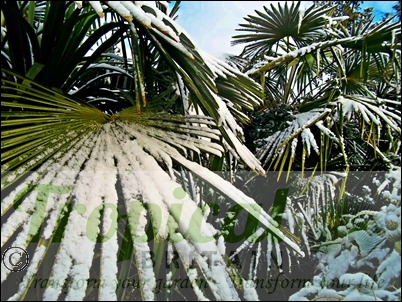Plant Care

This is not intended as an in-depth survey of the cultivation requirements of every imaginable exotic species but rather a very broad overview.
A strong dose of good down-to earth reality is needed to grow exotic plants in the UK. We have a climate that - although blessed with maritime winds and the beneficial effects of the Gulf Stream – is nonetheless somewhat challenging. Even in a mild winter, the frosts do their damage. There should be no illusion about this. Each geographic region has its own particular challenges and each garden has a different situation. However, with planning and careful thought, there is no reason why anyone in Great Britain can’t create a garden that has that magical exotic atmosphere.
Choosing reliably hardy species when first starting out is the best way to build up the backbone of your exotic garden. As you gather experience about what works in your area and slowly improve the level of protection you can offer your plants, you can gradually increase the range of species that you grow.
Trachycarpus fortunei - hardy to at least -20 C when mature
The most obvious way of increasing protection for your plants is to create an enclosed space. Depending on the area available this will either be the entire garden or an enclosed space within the larger garden. Walls, hedges, screens and fences will all contribute to providing an essential windbreak and creating an environment that offers increased protection. Creating the structure early on, including any hard landscaping will minimize disruption later. Once this initial outer framework has been achieved, the next step is to think about creating a canopy. Planting tall growing and ideally evergreen species with a broader habit is an ideal way of increasing protective winter cover from the frost, particularly if a further understory creates another protective layer. A planting of Fatsia japonica beneath a group of Trachycarpus fortunei, for instance, not only looks spectacular, but would also provide further cover for less hardy species, say Zantedsechia aethiopica or Z. albomaculata. Building up these levels within the enclosed framework is the basis for creating a microclimate in the exotic garden.
Fatsia japonica and Trachycarpus fortunei form an ideal low canopy for more tender plants planted beneath them
In such a space, a number of different methods can be employed to further increase the range of plants grown. Deep planting with good drainage and heavy mulching will assist many bulbs or rhizomes through the winter. When planting bulbs, adding generous quantities of grit and sand is - depending on the species - usually a sensible idea for increasing drainage and to minimise any chance of rot. Often it is not so much the cold that destroys the plant but poor drainage and resultant wet roots that freeze during a frost. For desert plants like Agaves and Opuntias it is essential to provide a very free draining and gritty substrate and to keep the roots as dry as possible. Insulating plant stems and foliage, either with natural materials or horticultural fleece is the key to protecting some species. Musa basjoo, for instance, is usually reliably root hardy in most areas, particularly if thickly mulched, while its less resilient pseudostems can be wrapped in fleece to give them frost protection. This way the banana, when it starts its growth in the spring, will have the benefit of the extra height and not have to start all of its new growth at ground level.
Exotic gardeners are by nature somewhat adventurous types. They tend towards trying to push the boundaries of what is possible. The dogged determination in the face of adversity that characterises so much of the British outlook tends to find a natural niche in exotic gardening - pitted against the elements and all that Nature can throw at it. This is just as well, for - as we all learn - so often a sense of over-optimism or misplaced enthusiasm can result in the loss of a much loved plant that proved just a little too tender. It is usually best to protect and foster the care of such plants; growing them on to a larger size or until we have more of them. If we have backup with some spare plants it may not matter too much if we lose one or two. Getting to know how a particular plant performs in your garden before trying to push it a bit further makes good sense. Often it is better to lift bulbs, corms or rhizomes and store them over winter than making the miscalculation of leaving them in the ground. There is no dishonour in this. After all, this is what gardeners have done with dahlias and the like for years. But if you do leave them in the ground, at least make sure they have a really good gritty drainage and a thick layer of mulch. It is always better to be safe than sorry.

This is not intended as an in-depth survey of the cultivation requirements of every imaginable exotic species but rather a very broad overview.
A strong dose of good down-to earth reality is needed to grow exotic plants in the UK. We have a climate that - although blessed with maritime winds and the beneficial effects of the Gulf Stream – is nonetheless somewhat challenging. Even in a mild winter, the frosts do their damage. There should be no illusion about this. Each geographic region has its own particular challenges and each garden has a different situation. However, with planning and careful thought, there is no reason why anyone in Great Britain can’t create a garden that has that magical exotic atmosphere.
Choosing reliably hardy species when first starting out is the best way to build up the backbone of your exotic garden. As you gather experience about what works in your area and slowly improve the level of protection you can offer your plants, you can gradually increase the range of species that you grow.
Trachycarpus fortunei - hardy to at least -20 C when mature
The most obvious way of increasing protection for your plants is to create an enclosed space. Depending on the area available this will either be the entire garden or an enclosed space within the larger garden. Walls, hedges, screens and fences will all contribute to providing an essential windbreak and creating an environment that offers increased protection. Creating the structure early on, including any hard landscaping will minimize disruption later. Once this initial outer framework has been achieved, the next step is to think about creating a canopy. Planting tall growing and ideally evergreen species with a broader habit is an ideal way of increasing protective winter cover from the frost, particularly if a further understory creates another protective layer. A planting of Fatsia japonica beneath a group of Trachycarpus fortunei, for instance, not only looks spectacular, but would also provide further cover for less hardy species, say Zantedsechia aethiopica or Z. albomaculata. Building up these levels within the enclosed framework is the basis for creating a microclimate in the exotic garden.
Fatsia japonica and Trachycarpus fortunei form an ideal low canopy for more tender plants planted beneath them
In such a space, a number of different methods can be employed to further increase the range of plants grown. Deep planting with good drainage and heavy mulching will assist many bulbs or rhizomes through the winter. When planting bulbs, adding generous quantities of grit and sand is - depending on the species - usually a sensible idea for increasing drainage and to minimise any chance of rot. Often it is not so much the cold that destroys the plant but poor drainage and resultant wet roots that freeze during a frost. For desert plants like Agaves and Opuntias it is essential to provide a very free draining and gritty substrate and to keep the roots as dry as possible. Insulating plant stems and foliage, either with natural materials or horticultural fleece is the key to protecting some species. Musa basjoo, for instance, is usually reliably root hardy in most areas, particularly if thickly mulched, while its less resilient pseudostems can be wrapped in fleece to give them frost protection. This way the banana, when it starts its growth in the spring, will have the benefit of the extra height and not have to start all of its new growth at ground level.
Exotic gardeners are by nature somewhat adventurous types. They tend towards trying to push the boundaries of what is possible. The dogged determination in the face of adversity that characterises so much of the British outlook tends to find a natural niche in exotic gardening - pitted against the elements and all that Nature can throw at it. This is just as well, for - as we all learn - so often a sense of over-optimism or misplaced enthusiasm can result in the loss of a much loved plant that proved just a little too tender. It is usually best to protect and foster the care of such plants; growing them on to a larger size or until we have more of them. If we have backup with some spare plants it may not matter too much if we lose one or two. Getting to know how a particular plant performs in your garden before trying to push it a bit further makes good sense. Often it is better to lift bulbs, corms or rhizomes and store them over winter than making the miscalculation of leaving them in the ground. There is no dishonour in this. After all, this is what gardeners have done with dahlias and the like for years. But if you do leave them in the ground, at least make sure they have a really good gritty drainage and a thick layer of mulch. It is always better to be safe than sorry.

Free DELIVERY
ON ALL ORDERS OVER £99THIS OFFER IS VALID ON ALL OUR STORE ITEMS.









